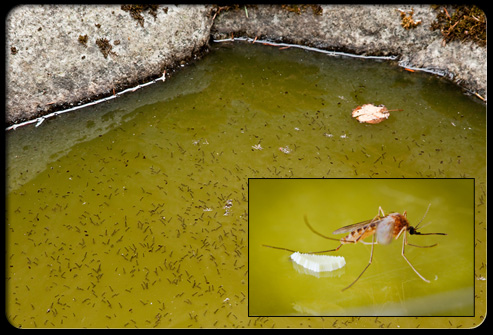
Nguyen Thi Yen rolls up the sleeves of her white lab coat and delicately slips her arms into a box covered by a sheath of mesh netting. Immediately, the feeding frenzy begins.
Hundreds of mosquitoes light on her thin forearms and swarm her manicured fingers. They spit, bite and suck until becoming drunk with blood, their bulging bellies glowing red. Yen laughs in delight while her so-called “pets” enjoy their lunch and prepare to mate.
The petite, grandmotherly entomologist _ nicknamed Dr. Dracula _ knows how crazy she must look to outsiders. But this is science, and these are very special bloodsuckers.
She smiles and nods at her red-hot arms, swollen and itchy after 10 minutes of feeding. She knows those nasty bites could reveal a way to greatly reduce one of the world’s most menacing infectious diseases.
All her mosquitoes have been intentionally infected with bacteria called Wolbachia, which essentially blocks them from getting dengue. And if they can’t get it, they can’t spread it to people.
New research suggests some 390 million people are infected with the virus each year, most of them in Asia. That’s about one in every 18 people on Earth, and more than three times higher than the World Health Organization’s previous estimates.
Known as “breakbone fever” because of the excruciating joint pain and hammer-pounding headaches it causes, the disease has no vaccine, cure or specific treatment. Most patients must simply suffer through days of raging fever, sweats and a bubbling rash. For those who develop a more serious form of illness, known as dengue hemorrhagic fever, internal bleeding, shock, organ failure and death can occur.
And it’s all caused by one bite from a female mosquito that’s transmitting the virus from another infected person.
So how can simple bacteria break this cycle? Wolbachia is commonly found in many insects, including fruit flies. But for reasons not fully understood, it is not carried naturally by certain mosquitoes, including the most common one that transmits dengue, the Aedes aegypti.
The germ has fascinated scientist Scott O’Neill his entire career. He started working with it about two decades ago at Yale University. But it wasn’t until 2008, after returning to his native Australia, that he had his eureka moment.
One of his research students figured out how to implant the bacteria into a mosquito so it could be passed on to future generations. The initial hope was that it would shorten the insect’s life. But soon, a hidden benefit was discovered: Wolbachia-infected mosquitoes not only died quicker but they also blocked dengue partially or entirely, sort of like a natural vaccine.
“The dengue virus couldn’t grow in the mosquito as well if the Wolbachia was present,” says O’Neill, dean of science at Monash University in Melbourne. “And if it can’t grow in the mosquito, it can’t be transmitted.”
But proving something in the lab is just the first step. O’Neill’s team needed to test how well the mosquitoes would perform in the wild. They conducted research in small communities in Australia, where dengue isn’t a problem, and the results were encouraging enough to create a buzz among scientists who have long been searching for new ways to fight the disease. After two and a half years, the Wolbachia-infected mosquitoes had overtaken the native populations and remained 95 percent dominant.
But how would it work in dengue-endemic areas of Southeast Asia? The disease swamps hospitals in the region every rainy season with thousands of sick patients, including many children, sometimes killing those who seek help too late.
The Australians tapped 58-year-old Yen at Vietnam’s National Institute of Hygiene and Epidemiology, where she’s worked for the past 35 years. Their plan was to test the Wolbachia mosquitoes on a small island off the country’s central coast this year, with another release expected next year in Indonesia.
Just getting the mosquitoes to Tri Nguyen Island was an adventure. Thousands of tiny black eggs laid on strips of paper inside feeding boxes had to be hand-carried inside coolers on weekly flights from Hanoi, where Yen normally works, to Nha Trang, a resort city near the island. The eggs had to be kept at just the right temperature and moisture. The mosquitoes were hatched in another lab before finally being transported by boat.
Yen insisted on medical checks for all volunteer feeders to ensure they weren’t sickening her mosquitoes. She deemed vegetarian blood too weak and banned anyone recently on antibiotics, which could kill the Wolbachia.
“When I’m sleeping, I’m always thinking about them,” Yen says, hunkered over a petri dish filled with dozens of squiggling mosquito pupae. “I’m always worried about temperature and food. I take care of them same-same like baby. If they are healthy, we are happy. If they are not, we are sad.”
Recently, there have been several promising new attempts to control dengue. A vaccine trial in Thailand didn’t work as well as hoped, proving only 30 percent effective overall, but it provided higher coverage for three of the four virus strains. More vaccines are in the pipeline. Other science involves releasing genetically modified “sterile” male mosquitoes that produce no offspring, or young that die before reaching maturity, to decrease populations.
Wolbachia could end up being used in combination with these and other methods, including mosquito traps and insecticide-treated materials.
“I’ve been working with this disease now for 40-something years, and we have failed miserably,” says Duane Gubler, a dengue expert at the Duke-NUS Graduate Medical School in Singapore who is not involved with the Wolbachia research.
“We are now coming into a very exciting period where I think we’ll be able to control the disease. I really do.”
Wolbachia also blocks other mosquito-borne diseases such as yellow fever and chikungunya, O’Neill says. Similar research is being conducted for malaria, though that’s trickier because the disease is carried by several different types of mosquitoes.
It’s unclear why mosquitoes that transmit dengue do not naturally get Wolbachia, which is found in up to 70 percent of insects in the wild. But O’Neill doesn’t believe that purposefully infecting mosquitoes will negatively impact ecosystems. He says the key to overcoming skepticism is to be transparent with research while providing independent risk analyses and publishing findings in high-caliber scientific journals.
“I think, intuitively, it makes sense that it’s unlikely to have a major consequence of introducing Wolbachia into one more species,” O’Neill says, adding that none of his work is for profit. “It’s already in millions already.”
Dengue typically comes in cycles, hitting some areas harder in different years. People remain susceptible to the other strains after being infected with one, and it is largely an urban disease with mosquitoes breeding in stagnant water.
Laos and Singapore have experienced their worst outbreaks in recent history this season. Thailand has also struggled with a large number of patients. Cases have also been reported in recent years outside tropical regions, including in the U.S. and Europe.
Vietnam has logged lower numbers this year overall, but the country’s highest dengue rate is in the province where Yen is conducting her work.
At the area’s main hospital in Nha Trang, Dr. Nguyen Dong, director of infectious diseases, says 75 of the 86 patients crammed into the open-air ward are infected with the virus.
Before jabbing his fingers into the stomach of one seriously ill patient to check for pain, he talks about how the dengue season has become much longer in recent years. And despite the government’s increased education campaigns and resources, the disease continues to overwhelm the hospital.
If the experiment going on just a short boat ride away from the hospital is successful, it eventually will be expanded across the city and the entire province.
The 3,500 people on Tri Nguyen island grew accustomed to what would be a bizarre scene almost anywhere else: For five months, community workers went house-to-house in the raging heat, releasing cups of newborn mosquitoes.
And the residents were happy to have them.
“We do not kill the mosquitoes. We let them bite,” says fisherman Tran To. “The Wolbachia living in the house is like a doctor in the house. They may bite, but they stop dengue.”
Specimens collected from traps are taken back to the lab for analysis to determine how well Wolbachia mosquitoes are infiltrating the native population.
The strain of bacteria used on the island blocks dengue 100 percent, but it’s also the hardest to sustain. At one point, 90 percent of the mosquitoes were infected, but the rate dropped to about 65 percent after the last batch was released in early September. A similar decrease occurred in Australia as well, and scientists switched to other Wolbachia strains that thrive better in the wild but have lesser dengue-blocking abilities.
The job is sure to keep Yen busy in her little mosquito lab, complete with doors covered by long overlapping netting.
And while she professes to adore these pests nurtured by her own blood, she has a much stronger motivation for working with them: Dengue nearly claimed her own life many years ago, and her career has been devoted to sparing others the same fate.
“I love them,” she says, “when I need them.”
Source: postbulletin






 At least 93 new dengue cases were reported Tuesday in Odisha, taking the total number of affected people to 2,593 since June, an official said.
At least 93 new dengue cases were reported Tuesday in Odisha, taking the total number of affected people to 2,593 since June, an official said.